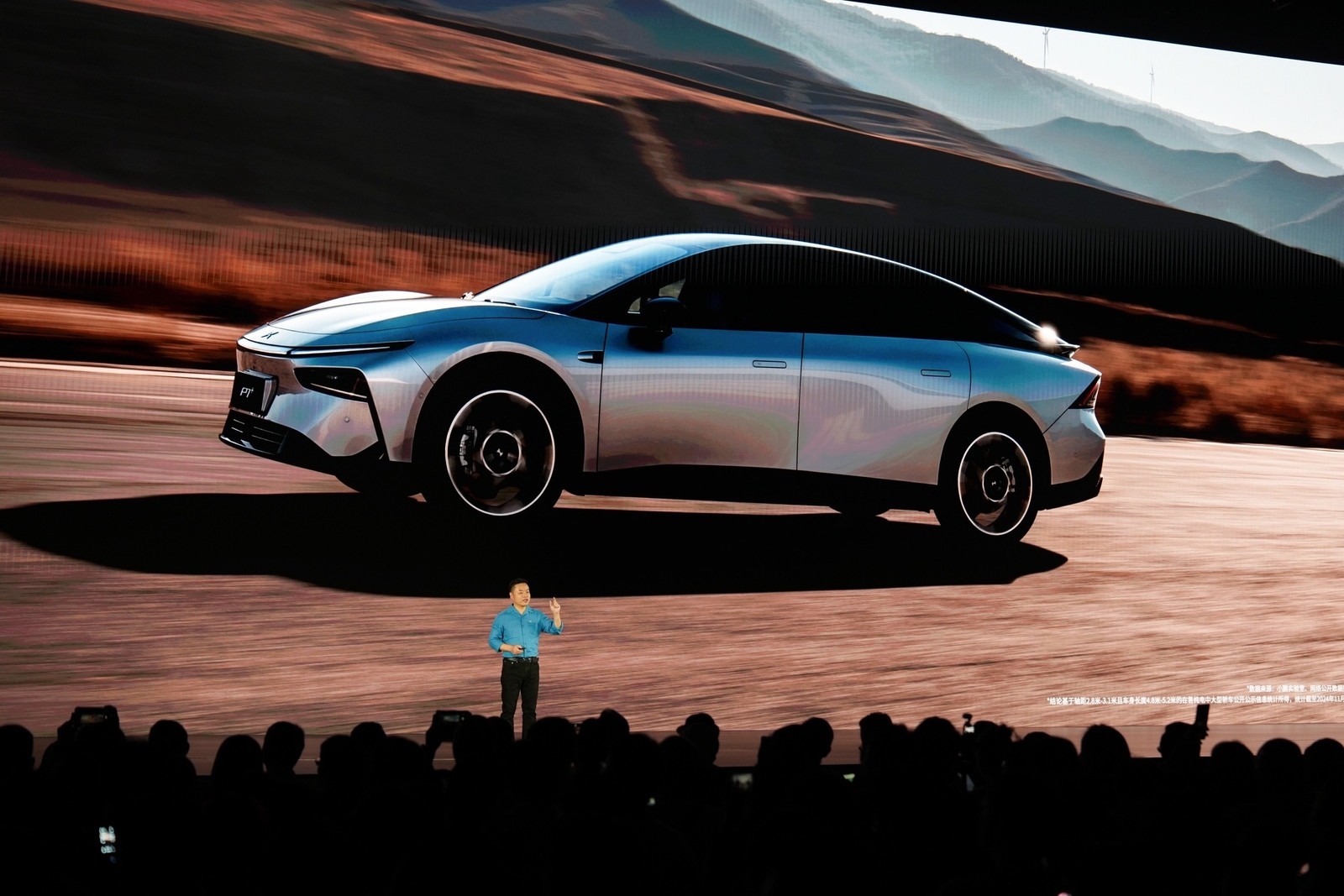Sign up for daily news updates from CleanTechnica on email. Or follow us on Google News!
Editor’s Note: This article was updated in September 2023 with new findings from WRI’s dataset tracking electric school bus adoption in the United States, covering January to June 2023. Our new data dashboard, updated monthly, has the most recent data on electric school bus adoption. Previous versions of this article are available for download at the bottom of this page.
Electric school bus adoption continues to expand in the United States. As of June 2023, there are 2,277 electric school buses that are either on order, delivered or operating. In total, there are now 5,982 committed electric school buses, an increase of almost 400 buses since the release of WRI’s December 2022 dataset and over 3,200 more buses since June 2022.
Thirty-nine percent of all committed electric school buses in the United States come from the Environmental Protection Agency’s (EPA) Clean School Bus Rebate Program, which awarded over $900 million for more than 2,300 electric school buses to 365 school districts in 2022, in its first round of funding. Thanks to this program, there are now electric school bus commitments in 49 states, Washington, D.C., American Samoa, Guam, Puerto Rico, the U.S. Virgin Islands and four tribal nations including the Morongo Band of Mission Indians, Mississippi Band of Choctaw Indians, Lower Brule Sioux Tribe and the Soboba Band of Luiseño Indians. We previously reported 50 states, but since our last update, Wyoming has returned their funding award.
This unprecedented level of funding comes from the Bipartisan Infrastructure Law of 2021 and would not have been possible without the tireless advocacy work of groups across the country.
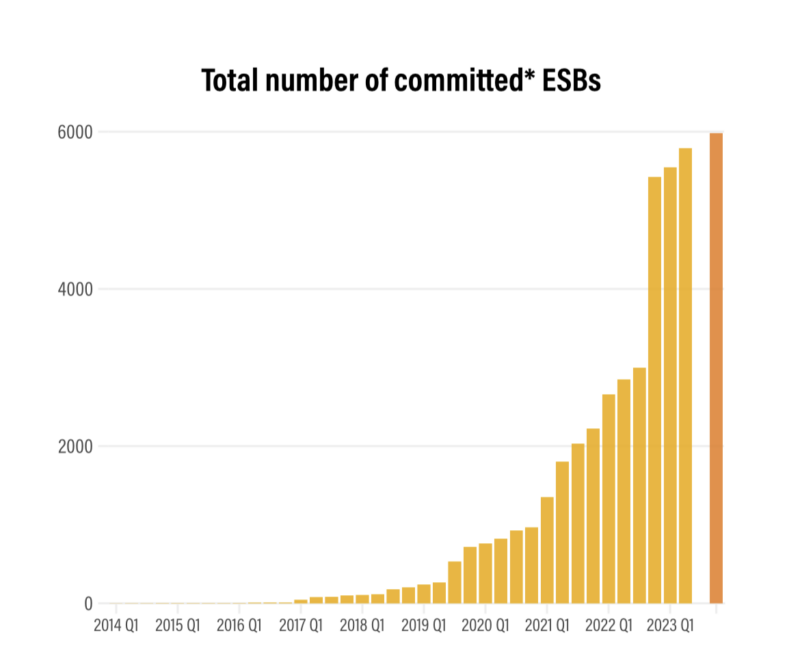
Source: Lazer and Freehafer, 2023 • Data as of June 2023. *awarded, ordered, delivered, or in operation. **190 ESBs added here due to unknown dates of their commitment stages.. WRI.
Why Are Electric School Buses Important?
More than 20 million children ride the bus to school and over 90% of these school buses run on diesel. Diesel exhaust, a known carcinogen, has proven links to serious physical health issues as well as cognitive development impacts. Daily exposure contributes to asthma and other respiratory diseases. Last year, the Electric School Bus Initiative published the first nationwide dataset of asthma rates by school district, based on census tract-level data from CDC PLACES and found that encouragingly, nearly 50% of electric school buses are in areas with high rates of adult asthma. This is especially important, as evidence suggests that children are especially susceptible to these impacts.
Students from low-income families are particularly exposed to the dangers of diesel exhaust pollution: 60% ride the bus to school, compared to 45% of students from families with higher incomes. In addition, Black students and children with disabilities rely on school buses more than their peers, meaning they’re more likely to be exposed to diesel exhaust. Children of color are also more likely to suffer from asthma, due in part to historically racist lending, transit, housing and zoning policies that concentrated Black and Brown communities closer to highways and other sources of vehicle-based air pollution. Electrifying the entire fleet of school buses can help address these health concerns and inequalities.
Electric school buses don’t have any tailpipe emissions, reducing students’ exposure to harmful pollutants, which studies have shown can have positive and significant effects on student test scores — in some cases, on par with increased teacher experience levels.
Electric school buses produce less than half the greenhouse gas emissions of diesel or propane-powered school buses, even after accounting for emissions for electricity generation. Plus, unlike other fuels, the use of electric buses will continue to reduce greenhouse gas emissions from the transportation sector as more electricity generation comes from renewable energy. School bus electrification can also offer resiliency support to the electric grid by providing access to large batteries when not in use and add jobs in the growing electric vehicle industry, although this transition needs to be thoughtfully managed with equity considerations in mind.
WRI has been tracking electric school bus adoption across the U.S. and recently released updated data covering the first and second quarters of 2023.
Here are the key findings and trends from this new data:
The United States Has Almost 6,000 Committed Electric School Buses; More Than 1,200 Are on the Road Today
We consider an electric school bus “committed” when a school district or fleet operator has been awarded funding to purchase it or has made a formal agreement for a purchase with a dealer or manufacturer. Committed buses also include those in operation and buses that have been delivered to the school district or fleet operator.
As of June 2023, we identified 5,982 electric school buses that have been awarded, ordered, delivered or are operating across 914 U.S. school districts or private fleet operators. There are more than triple the number of districts since our first count in the summer of 2021, while the amount of electric school buses committed has increased five-fold. We estimate approximately 69,000 students across the country are currently served by electric school buses that are delivered or in operation.
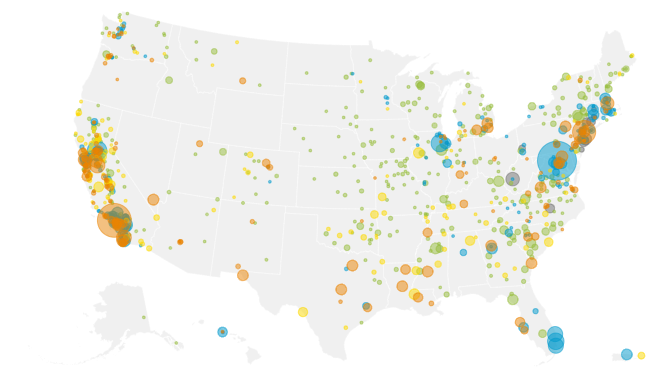
Source: Lazer and Freehafer, 2023, National Center for Education Statistics, 2022 • For locale definitions, see here. Data as of June 2023. *awarded, ordered, delivered, or in operation. Not shown: American Samoa Department of Education (1 ESB, Town) and Guam Department of Education (25 ESBs, Town). WRI.
We collect data on four phases of the electric school bus adoption process that fit under the umbrella term “committed:” “awarded,” “ordered,” “delivered” and “in operation.” As of June 2023, there are 992 electric school buses on order, more than twice the number in December 2022, affirming that there is significant follow-through by districts that receive electric school bus awards. Approximately 1,285 electric school buses in 40 states have been delivered or are in operation — about the size of the entire school bus fleet of Broward County Public Schools in Florida. This is an increase of more than 300 buses in communities since December 2022.
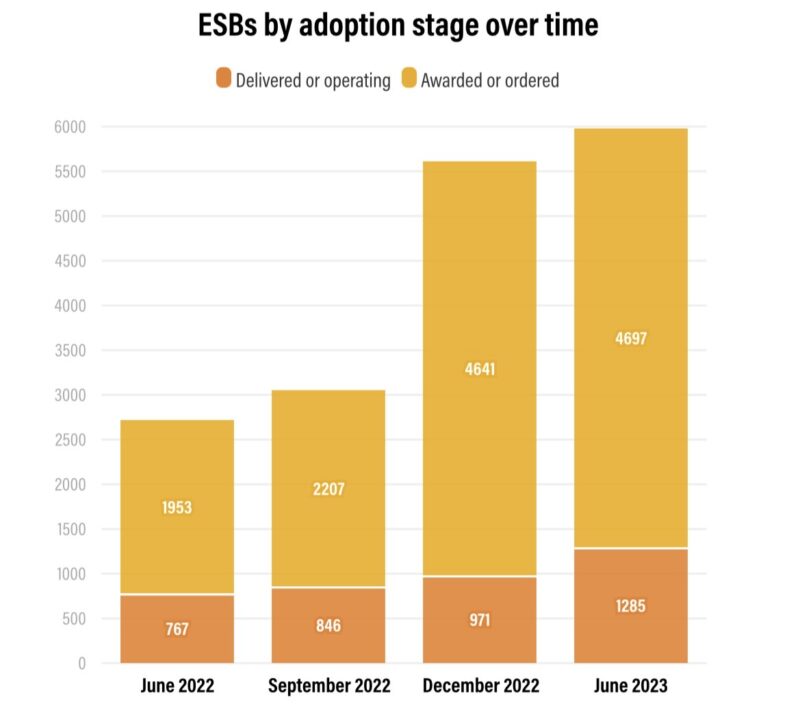
Source: Lazer and Freehafer, 2023 • Data as of June 2023 WRI.
Forty-nine states have electric school bus commitments, in addition to five tribal schools, one private school operated by a tribal nation, Washington, D.C., American Samoa, Guam, Puerto Rico and the U.S. Virgin Islands.
Our research shows that an average of 16 months passes between the awarding of funds to the delivery of the electric school bus. This range varies from less than three months to almost four years, but the amount of overall time is less since the first electric school bus hit the roads in 2014. Supply chain issues during the COVID-19 pandemic have exacerbated delivery delays for all school bus types. While these have improved since 2020, such delays are expected to continue for some time.
Electric School Buses are Committed in 49 States; One-Third are in the South

Source: Lazer and Freehafer, 2023 • Data as of June 2023. *awarded, ordered, delivered, or in operation. Not shown: American Samoa (1 ESB), Guam (25 ESBs), and U.S. Virgin Islands (10 ESBs). WRI.
Forty-nine states have electric school bus commitments, in addition to five tribal schools, one private school operated by a tribal nation, Washington, D.C., American Samoa, Guam, Puerto Rico and the U.S. Virgin Islands.
As of June 2023, 119 electric school buses funded by EPA’s Clean School Bus Rebate Program have been delivered or are already operating and at least another 349 are on order, representing more than 100 school districts in 32 states.
California still leads in electric school bus adoption, with over 2,000 committed electric buses across the state, at least 34% of which are delivered or operating. This is more than five times as many buses as the next leading state, Maryland, with 391 commitments. California also has the largest increase since December 2022, with 226 new commitments. New Jersey has the second largest increase with 107 new committed electric school buses. New Jersey is also now within the top 10 states with the most committed electric school buses for the first time since tracking began. West Virginia has the third largest increase with 42 new commitments. The updated data shows electric school bus commitments are now more evenly distributed across the country.
Before October 2022, 59% of electric school bus commitments were in the West (based on U.S. Census regions), including over 50% in California. Now, California represents just 35% of committed electric school buses, only a little more than the South’s 33% share of commitments. New England and the Midwest have 16% and 10% respectively of committed electric school buses.
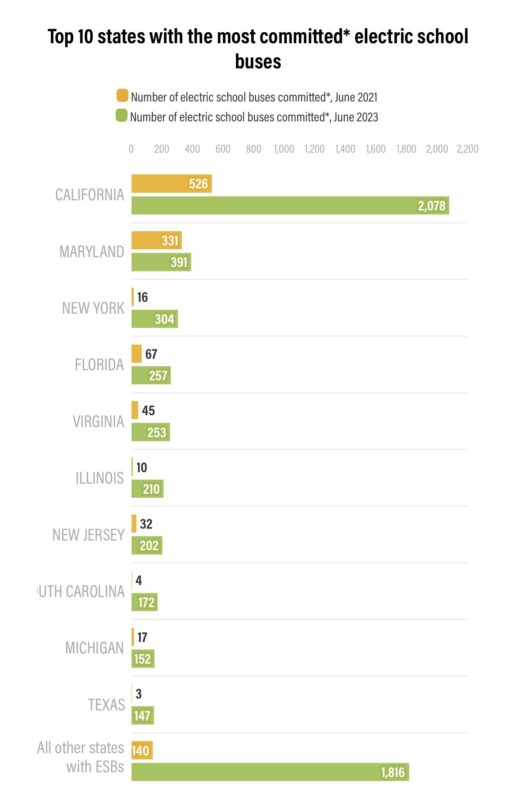
Source: Lazer and Freehafer, 2023 • Data as of June 2023. *awarded, ordered, delivered, or in operation. WRI.
With 2,339 electric school buses awarded — and more on the way — the EPA’s Clean School Bus Program far surpasses any other single funding source by the number of buses funded. The next largest funding source is California’s Hybrid and Zero-Emission Truck and Bus Voucher Incentive Program (HVIP), which has funded 1,029 buses. Unsurprisingly, California-specific funding sources comprise five out of the 10 largest funding sources. The state’s robust incentive programs are partly why more than half of all delivered and operational electric school buses can be found there.
Top 10 Electric School Bus Funding Sources
Rank – Funding Source – Funding Administrator – Number of ESBs Funded
- Clean School Bus Rebate Program – Environmental Protection Agency (EPA) – 2,339
- California’s Hybrid and Zero-Emission Truck and Bus Voucher Incentive Program – California Air Resources Board – 1,029
- Volkswagen Settlement – Multiple – 712
- School Bus Replacement Program – California Energy Commission – 228
- Regional Greenhouse Gas Initiative – Multiple (MA and NJ) – 187
- Rural School Bus Pilot Project – California Air Resources Board – 143
- Diesel Reduction Act – EPA – 140
- Carl Moyer Program – California Air Resources Board – 133
- Community Air Protection Incentive Program – California Air Resources Board -108
- Electric School Bus Program – Dominion Energy (VA) – 59
Source: Lazer and Freehafer, 2023
The Number of Large Commitments for Electric School Buses Is Growing
Most of the 914 U.S. school districts or private fleet operators with electric school buses — around 71% — have committed to more than one bus. One-third of all entities with electric school buses have committed to five or more and 162 (18%) have committed to 10 or more, compared to 60 school districts just one year ago. Forty-nine states, plus Washington, D.C., Guam, Puerto Rico, the U.S. Virgin Islands and three tribal nations have at least two electric school bus commitments. Seventy-two districts have electric school bus commitments that amount to 50% or more of their current fleet size and 14 districts currently have a school bus fleet that is at least half electric. These numbers suggest growing trust in electric school bus technology and market conditions, as well as wider funding availability.
Top 5 School Districts by Number of Electric School Buses Committed*
Rank – Entity name – State – Number of ESBs
- Montgomery County Public Schools – MD – 326
- Los Angeles Unified School District – CA – 253
- New York City Public Schools – NY – 118
- Twin Rivers Unified School District – CA – 84
- Troy Community Consolidated School District 30-C IL – 64
Source: Lazer and Freehafer, 2023
*awarded, ordered, delivered or in operation.
Top 5 School Districts by Number of Electric School Buses Delivered or in Operation
Rank – Entity name – State – Number of ESBs
- Montgomery County Public Schools – MD -86
- Broward County Public Schools – FL – 60
- Twin Rivers Unified School District – CA – 58
- Moreno Valley Unified School District – CA – 42
- Baltimore City Public Schools – MD – 25
Source: Lazer and Freehafer, 2023
More Than 150 Districts with Electric School Buses have Gone Back for More
The dataset includes information on “batches,” or groups of electric school buses that went through the adoption process at the same time. We consider a district’s buses to be in the same batch if one of their adoption phases — when they were awarded, ordered, delivered or first operating — occurred within roughly six months of each other. For example, if a district ordered five buses in January and then ordered five more in May of the same year, those 10 buses would all be grouped into one batch. This variable can help to demonstrate adoption patterns at the school district level, like how batches differ in size and how long it takes before districts receive an additional batch.
The average time between a district’s batches is a little over a year. Since December 2022, 24 districts have added a batch of electric school buses, bringing the total number of districts with more than one batch to 162. Fifteen districts have four batches, and one district, Los Angeles Unified School District, has five. We found that most batches are small, with a median size of two buses. However, the batch sizes range widely, suggesting that they may be largely dependent on the amount and type of funding and financing available at the time.
Larger Buses Dominate Electric School Bus Sales
School buses are generally classified into four categories based on size and construction: the smaller types A and B, which carry between 10 and 30 passengers and the larger types C and D, which carry between 50 and 90 students. The four largest manufacturers all offer Type C electric models, which is the most common bus type, according to a 2021 maintenance survey conducted by School Bus Fleet Magazine. This aligns with our findings on electric school bus types; 63% of committed electric school buses are Type C, while 22% are the bigger Type D. Sixteen percent of electric school buses are Type A. Only a handful of electric school buses are Type B.
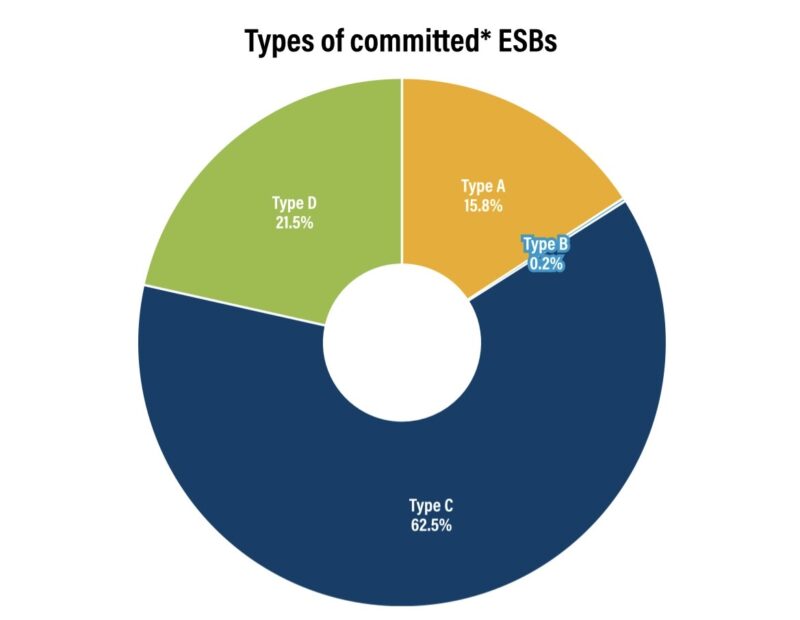
Source: Lazer and Freehafer, 2023 • Data as of June 2023*awarded, ordered, delivered, or in operation. 3,147 excluded due to missing data. Data is unavailable for number of accessible buses. WRI.
Is Electric School Bus Adoption Occurring Equitably?
EPA’s Clean School Bus Program prioritized school districts based on whether they were “high need” (including high-poverty districts and those located in the U.S. Virgin Islands, Guam, American Samoa or Northern Mariana Islands), rural, tribal or a combination of these criteria. Out of all committed electric school buses nationwide that fit into the criteria of low-income, rural, tribal or located in a U.S. territory, the Clean School Bus Program funded most electric school buses in each of these categories. Notably, the Clean School Bus Program led to a more equitable distribution of electric school buses across locales. The share of districts with at least one electric school bus in each locale (rural, town, suburban and urban) aligns almost exactly to the distribution of all school districts nationwide among these locales. Forty percent of school districts with at least one committed electric school bus are in rural locales, 24% are in suburban, 20% are in urban and 15% are in town locales.
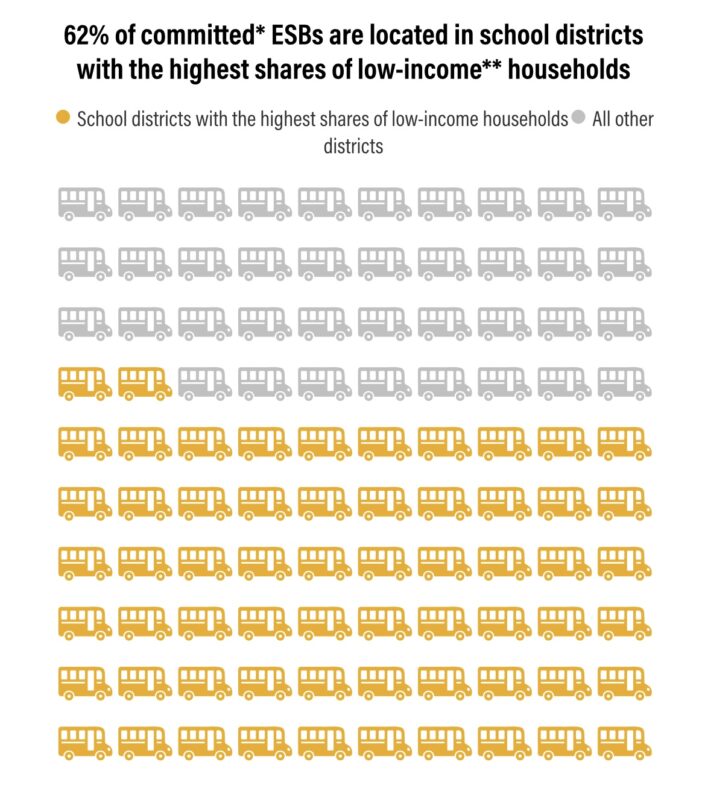
Source: Lazer and Freehafer, 2023, National Center for Education Statistics, 2022, EPA EJScreen, 2023 • Data as of June 2023. 96 districts and 640 buses excluded due to missing data. *awarded, ordered, delivered, or in operation. **A “low-income” household has a household income less than twice the federal poverty level. School districts with the highest shares of low-income households are in the top 50% of districts by shares of low-income households (>28% of households). WRI.
The amount of electric school buses in school districts with the highest shares of low-income households has increased significantly, mostly due to the Clean School Bus Program’s prioritization of low-income school districts. In June 2022, the largest percentage of electric school buses were in districts with the smallest shares of low-income households. Now, 62% of committed electric school buses are in districts with the highest shares of low-income households.
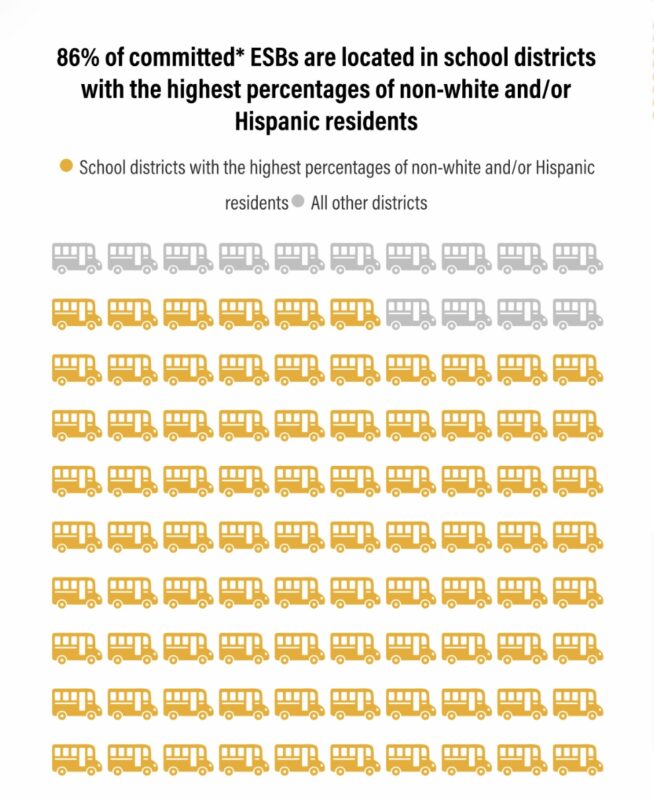
Source: Lazer and Freehafer, 2023, National Center for Education Statistics, 2022, EPA EJ Screen, 2023 • Data as of June 2023. 96 districts and 640 buses excluded due to missing data. *awarded, ordered, delivered, or in operation. School districts with the highest percentages of non-white and/or Hispanic residents are in the top 50% of all districts by percentage of non-white and/or Hispanic residents (>15% of residents).WRI.
Electric school bus adoption appears to be occurring equitably when looking at how the vehicles are distributed among communities of color. Eighty-six percent of committed electric school buses are in school districts with the highest percentages of non-white/Hispanic residents (defined as “people of color” in the EPA’s EJScreen data). The Clean School Bus Program did not use race or ethnicity as prioritization criteria, so policymakers, utilities, nonprofit organizations and teams charged with program design and implementation should commit to ensuring this trend continues.
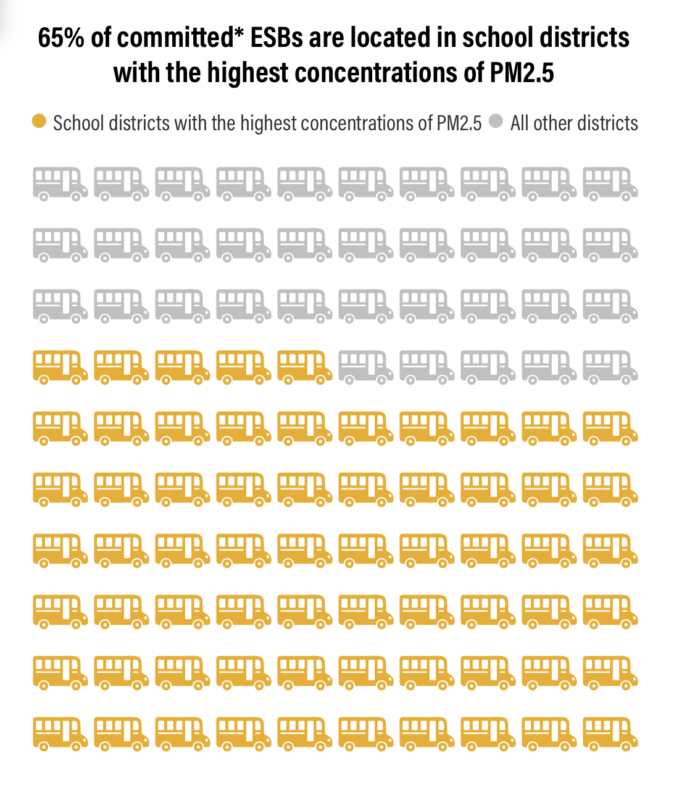
Source: Lazer and Freehafer, 2023, National Center for Education Statistics, 2022, EPA EJScreen, 2023 • Data as of June 2023.Data as of June 2023. 96 districts and 640 buses excluded due to missing data.
*awarded, ordered, delivered, or in operation. School districts with the highest concentrations of ozone pollution are in the top 50% of all districts by ozone pollution.WRI.
We compiled data on concentrations of Particle Matter (PM2.5) and ozone in school districts because of the harmful health effects of these pollutants, their close linkage to diesel exhaust and the availability of data. The data shows school districts with the highest levels of PM2.5 air pollution have committed more electric school buses. Over two thirds of committed electric school buses are located in school districts with the highest concentrations of PM2.5.

Source: Lazer and Freehafer, 2023, National Center for Education Statistics, 2022, EPA EJScreen, 2023 • Data as of June 2023.• Data as of June 2023. 92 districts and 598 buses excluded due to missing data.
**Asthma data for children under the age of 18 was not available at the census tract level. School districts with the highest adult asthma rates are in the top 50% of all districts by adult asthma rates (>10% of adults).WRI.
The trend continues with ozone pollution. Approximately three-quarters of committed electric school buses are in districts with the highest concentrations of ozone pollution.
School districts with electric school buses are fairly evenly distributed among different levels of adult asthma rates. A little less than half (43%) of committed electric school buses are in school districts with the highest adult asthma rates.
Approximately 57% of committed electric school buses are in school districts with lower adult asthma rates. Efforts must continue to ensure that electric school buses are brought first to communities that will benefit the most from air quality improvements.
Overall, committed electric school buses are largely concentrated in historically underserved school districts. Since tracking began, we have seen an increase in buses in low-income areas and areas with the highest levels of PM2.5 and ozone pollution. A majority of electric school buses continue to be in school districts with high populations of non-white and/or Hispanic residents. As electric school bus adoption continues to scale up across the United States, we must continue to center communities that disproportionately bear the burden of on-road air pollution.
It’s important to note that the metrics we have chosen are by no means comprehensive. WRI is conducting more in-depth research on the equity of electric school bus adoption and continuing to work alongside partners to ensure that underserved communities remain front-and-center in the transition.
What’s Next to Scale Up Electric School Bus Adoption?
Our most recent update to WRI’s Electric School Bus Adoption dataset saw a continued increase in the number of committed buses, in large part due to awards through EPA’s Clean School Bus Program. We also recorded a twofold increase in the number of electric school buses on order over the last six months and an increase of over 100 buses in operation. This signals that there is significant follow-through by districts that receive electric school bus awards, and that funding is putting more buses on the road.
A second round of federal funding, in the form of a grant program through the EPA, recently closed its application cycle on August 22, 2023. Another round of rebates by the EPA’s Clean School Bus Program is expected to open later this year. In addition, in June 2023, the Internal Revenue Service (IRS) issued proposed regulations for elective payment options for claiming certain clean energy tax credits — which allows entities like school districts to claim electric school bus-relevant credits such as 45W (Qualified Commercial Clean Vehicles) and 30C (Alternative Fuel Vehicle Refueling Property Credit). The IRS is expected to release a pre-filing registration portal later this year, which would allow school districts to take the first step in applying for the credits.
State legislatures are also bolstering the electric school bus transition. Since 2022, five states have statutorily enacted zero-emission school bus transition mandates, including Connecticut, Delaware, Maryland, Maine, and New York. Delaware is the most recent state to enact its transition mandate in August 2023, requiring that 30% of new school buses be electric by 2030. Colorado, Michigan, and Washington D.C. have non-binding transition goals, aiming for 100% zero-emission buses on the road by 2035,100% of school bus sales to be electric by 2030, and the replacement of 100% of school buses with electric models beginning in 2021, respectively. Approximately 20% of school buses and 16% of all school bus riders are impacted by these targets. In July 2023, Michigan further demonstrated their commitment to electric school buses by passing a historic budget that included $125 million for Michigan’s Clean School Bus Program. Washington State has also allocated $100 million toward the procurement of zero-emission medium- and heavy-duty vehicles, including school buses.
This progress has spurred the consideration of funding and fleet transition targets and propositions in even more states, including California, Hawaii, Illinois, and Massachusetts.
This latest data shows that electric school buses have nationwide momentum. If progress toward an all-electric school bus fleet is to persist, policymakers at the federal and state levels, including state utility regulators, need to continue establishing electric school bus enabling policies, such as fleet transition targets and programs to support charging infrastructure deployment. Federal and state governments can continue to address the upfront cost premium of electric school buses through new and augmented funding opportunities and, importantly, financing programs that help maximize the impact and reach of grants and leverage them for greater scale and ambition. Across these efforts, policymakers should ensure benefits are equitably accessible to communities that would benefit most from school bus electrification.
View past editions of this article:
April 2023 Edition
February 2023 Edition
September 2022 Edition
June 2022 Edition
February 2022 Edition
August 2021 Edition
Courtesy of WRI. By Lydia Freehafer, Leah Lazer and Brian Zepka
Have a tip for CleanTechnica? Want to advertise? Want to suggest a guest for our CleanTech Talk podcast? Contact us here.
EV Obsession Daily!
I don’t like paywalls. You don’t like paywalls. Who likes paywalls? Here at CleanTechnica, we implemented a limited paywall for a while, but it always felt wrong — and it was always tough to decide what we should put behind there. In theory, your most exclusive and best content goes behind a paywall. But then fewer people read it!! So, we’ve decided to completely nix paywalls here at CleanTechnica. But…
Thank you!
Tesla Sales in 2023, 2024, and 2030
CleanTechnica uses affiliate links. See our policy here.




